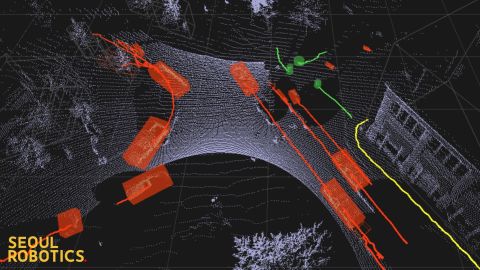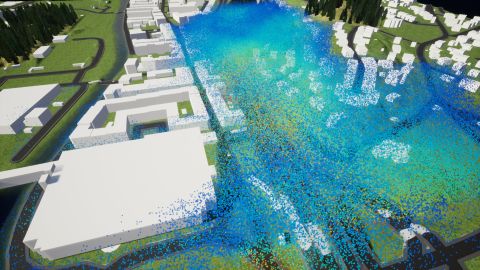CNN
—
With space in our cities at a premium, and a majority of the world’s population expected to live in urban areas within the next few decades, there’s less room for trial-and-error when it comes to urban planning – with decisions made today having critical impacts on the future.
But what if there was a way to test and analyze different scenarios first, before ever breaking ground? That’s the thinking behind “digital twins” that are being made of cities all over the world, including Shanghai, New York, Singapore and Helsinki.
Digital twins elevate traditional 3D city models to new possibilities, says Anders Logg, a professor of computational mathematics and director of the Digital Twin Cities Centre at Chalmers University of Technology in Sweden. Using real-time data and artificial intelligence, digital twins become virtual, living mirrors of their physical counterparts – providing opportunities to simulate everything from infrastructure and construction to traffic patterns and energy consumption.
Designing the cities of the future
Chattanooga, a city of roughly 180,000 people, is nestled in foothills of the Appalachian Mountains, situated almost equidistant from the larger cities of Atlanta, Georgia, to the south and Nashville, Tennessee to the north. While larger urban areas typically get the most attention for their digital twin projects, Chattanooga is a strong test case for the US because its smaller size allows it to be more agile, says Kevin Comstock, consultant with KCI Technologies and former Smart City director for Chattanooga.
The city of Chattanooga and its various collaborators, including Oak Ridge National Laboratory and the University of Tennessee at Chattanooga, have tackled individual issues and areas by creating digital twin projects.
The first, called “CTwin,” focused on one of the city’s major roadways to examine mobility-related energy use by building a digital representation of traffic signal infrastructure, says Comstock. Another ongoing project uses sensors and laser imaging at intersections to monitor pedestrian movements and compare it to vehicle traffic, in the interest of safety.
“If we know where pedestrians are in the intersection, and we know where cars are in the intersection, we can begin to mimic ‘near-miss’ activity,” Comstock says, by tracking pedestrians and bicyclists who alter their course to avoid cars.
Related: Are microcars the smaller, green future of urban driving?
Unlike actual accidents, those near misses aren’t usually reported. Collecting data on them would provide more accurate information on how safe an intersection is, says Comstock, enabling him to figure out how to resolve issues.

Can this be scaled up for larger cities? “Bigger cities have bigger problems,” says Dr. Ville Lehtola, assistant professor at the University of Twente in the Netherlands. “But it’s also some of the same problems experienced by smaller cities … so if you do the planning well, there will be less risks and the actual operation costs of construction and other operations will be cheaper. Doing better planning pays off.”
Lehtola is a former city councilor in Espoo, Finland, just outside of Helsinki. He says when a new metro line was proposed, Espoo first digitized the planning of the operations and construction. The digital twin can reveal what the finished job will look like, Lehtola says, “so you could show (the public) for example, if there’s some construction work or land development taking place, what is the outcome, how it will look, and then also get more precision on the estimates on the benefits and useability and added value of different projects.”
Logg says there are two fundamental questions to answer when creating digital twin cities: “What is analyzed to fit the current state of the city?” and “how can we predict how the city will behave?”
He points to Gothenburg, Sweden, which has taken data from sources including regular street maps to generate its digital twin. “From the data you can add things like park benches, the atmosphere, clouds, (and) water,” Logg says, and then use that raw data to create a visual model of how a new building would impact wind patterns, for example, or even potential pitfalls lurking underground.
“(Gothenburg) is built on clay, so it becomes very important to model the behavior of the clay,” he says. “What happens if you start a new, big infrastructure project? Will there be any potential risk of digging or building new tunnels?”
Related: Why the future of our cities might be headed underground
The key to success is what Logg calls “data sustainability” – the frequent, real-time updates feeding into the digital twin to keep pace with the constant evolution of the physical city. Otherwise, he says, the digital twin model “becomes stale.”
Globally, investment in digital twins is already starting to pay off. A 2021 report by global tech firm ABI Research estimates cities will save $280 billion by 2030 “by using digital twins for more efficient urban planning.” According to another report from accounting and consulting firm PwC, digital twins can also help with sustainability efforts, one of the original aims of the “smart city” movement.
More data points are becoming available to inform the models, with sources including autonomous cars, delivery drones, and construction equipment outfitted with smart sensors, Lehtola says. As the technological possibilities increase, so do the challenges, especially with regards to gathering, storing and protecting that much data, he adds.

Breaking various stakeholders from their individual “silos,” he says, is also important, so the data can be shared and make all facets of city planning more efficient.
The technical challenges are considerable, agrees Logg, because cities are extremely complex systems. But, he adds, “those are challenges that we are used to as researchers and developers.”
Logg sees a future where everything from building maintenance and new construction to roads and traffic signals will be “integrated and connected,” allowing city planners to make decisions that will still make sense decades down the line.
Digital twins “will be everywhere,” he says, “(as) the system that answers all your questions about future plans.”

 “Forest City” for 130,000 inhabitants in Cancun, Mexico. In its plans the city is surrounded by a ring of solar panels and fields for agriculture, which would be irrigated by a water channel connected by an underwater pipe. ” class=”image_gallery-image__dam-img image_gallery-image__dam-img–loading” onload=’this.classList.remove(‘image_gallery-image__dam-img–loading’)’ height=”2348″ width=”3600″/>
“Forest City” for 130,000 inhabitants in Cancun, Mexico. In its plans the city is surrounded by a ring of solar panels and fields for agriculture, which would be irrigated by a water channel connected by an underwater pipe. ” class=”image_gallery-image__dam-img image_gallery-image__dam-img–loading” onload=’this.classList.remove(‘image_gallery-image__dam-img–loading’)’ height=”2348″ width=”3600″/>


 New Clark City is still being constructed, about 100 kilometers north of the capital, Manila.” class=”image_gallery-image__dam-img image_gallery-image__dam-img–loading” onload=’this.classList.remove(‘image_gallery-image__dam-img–loading’)’ height=”1128″ width=”2000″/>
New Clark City is still being constructed, about 100 kilometers north of the capital, Manila.” class=”image_gallery-image__dam-img image_gallery-image__dam-img–loading” onload=’this.classList.remove(‘image_gallery-image__dam-img–loading’)’ height=”1128″ width=”2000″/> natural disaster such as an earthquake, typhoon, or flooding. Plans to make the city pollution-free include using green energy and constructing buildings that consume little energy. The first phase of development is
natural disaster such as an earthquake, typhoon, or flooding. Plans to make the city pollution-free include using green energy and constructing buildings that consume little energy. The first phase of development is  equivalent to the size of Monaco. ” class=”image_gallery-image__dam-img image_gallery-image__dam-img–loading” onload=’this.classList.remove(‘image_gallery-image__dam-img–loading’)’ height=”889″ width=”1600″/>
equivalent to the size of Monaco. ” class=”image_gallery-image__dam-img image_gallery-image__dam-img–loading” onload=’this.classList.remove(‘image_gallery-image__dam-img–loading’)’ height=”889″ width=”1600″/>
 smart city being built from scratch on the outskirts of Helsinki, Finland. Developers say the city is due for completion in 2035 and residents will gain
smart city being built from scratch on the outskirts of Helsinki, Finland. Developers say the city is due for completion in 2035 and residents will gain  vacuum waste system for the city, where people simply take their trash to a port and it gets sucked to an underground disposal center.” class=”image_gallery-image__dam-img image_gallery-image__dam-img–loading” onload=’this.classList.remove(‘image_gallery-image__dam-img–loading’)’ height=”1422″ width=”2133″/>
vacuum waste system for the city, where people simply take their trash to a port and it gets sucked to an underground disposal center.” class=”image_gallery-image__dam-img image_gallery-image__dam-img–loading” onload=’this.classList.remove(‘image_gallery-image__dam-img–loading’)’ height=”1422″ width=”2133″/> Sustainable City in Dubai is designed to consume zero net energy, and has the potential to go off-grid. ” class=”image_gallery-image__dam-img image_gallery-image__dam-img–loading” onload=’this.classList.remove(‘image_gallery-image__dam-img–loading’)’ height=”2250″ width=”4000″/>
Sustainable City in Dubai is designed to consume zero net energy, and has the potential to go off-grid. ” class=”image_gallery-image__dam-img image_gallery-image__dam-img–loading” onload=’this.classList.remove(‘image_gallery-image__dam-img–loading’)’ height=”2250″ width=”4000″/> solar panels. All water is recycled on site, there are no cars, and the complex grows its own vegetables in 11 biome greenhouses. ” class=”image_gallery-image__dam-img image_gallery-image__dam-img–loading” onload=’this.classList.remove(‘image_gallery-image__dam-img–loading’)’ height=”1711″ width=”2567″/>
solar panels. All water is recycled on site, there are no cars, and the complex grows its own vegetables in 11 biome greenhouses. ” class=”image_gallery-image__dam-img image_gallery-image__dam-img–loading” onload=’this.classList.remove(‘image_gallery-image__dam-img–loading’)’ height=”1711″ width=”2567″/>
 operational in 18 months. ” class=”image_gallery-image__dam-img image_gallery-image__dam-img–loading” onload=’this.classList.remove(‘image_gallery-image__dam-img–loading’)’ height=”960″ width=”1280″/>
operational in 18 months. ” class=”image_gallery-image__dam-img image_gallery-image__dam-img–loading” onload=’this.classList.remove(‘image_gallery-image__dam-img–loading’)’ height=”960″ width=”1280″/>
 coastal erosion and storm surges, but critics claim the wall could
coastal erosion and storm surges, but critics claim the wall could 
 Reuters reported that Kenya had secured 67.5 billion shillings ($620 million) in funding from China, partly to build a data center for Konza, and that Huawei would work on the project.” class=”image_gallery-image__dam-img image_gallery-image__dam-img–loading” onload=’this.classList.remove(‘image_gallery-image__dam-img–loading’)’ height=”971″ width=”1500″/>
Reuters reported that Kenya had secured 67.5 billion shillings ($620 million) in funding from China, partly to build a data center for Konza, and that Huawei would work on the project.” class=”image_gallery-image__dam-img image_gallery-image__dam-img–loading” onload=’this.classList.remove(‘image_gallery-image__dam-img–loading’)’ height=”971″ width=”1500″/> most sustainable cities in the world. At least 60% of the city will be covered in greenery or water, and its
most sustainable cities in the world. At least 60% of the city will be covered in greenery or water, and its 